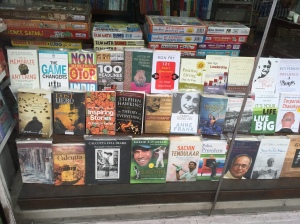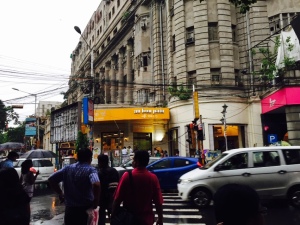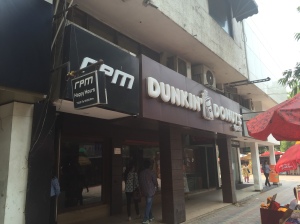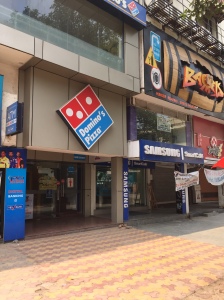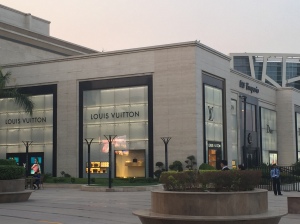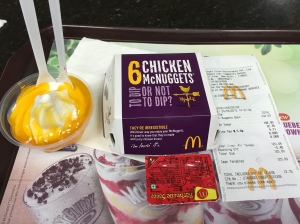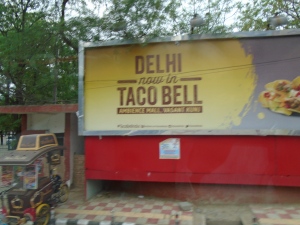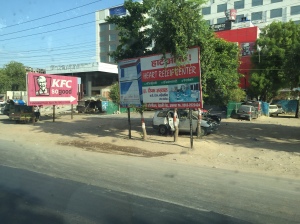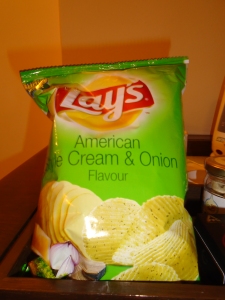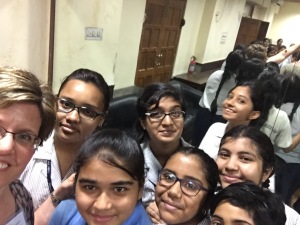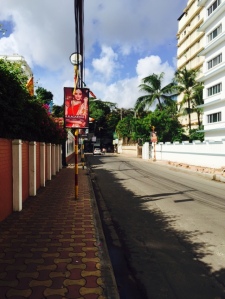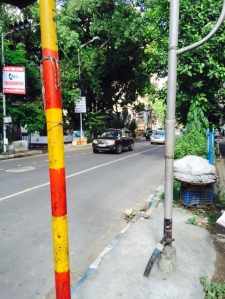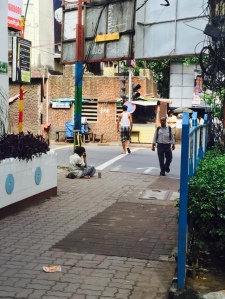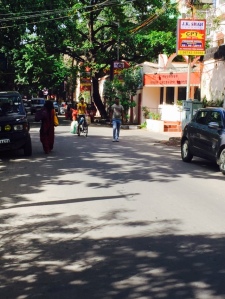India
3 Cities of India
Growing up in rural NH and having lived in Maine, Vermont, and now back in NH, I am used to a rural lifestyle. My husband, sons and I live in a small house and own 25 acres of land with a large yard, a pond, hiking trails, forest, and we can’t see anyone from our property. My commute to school is an easy 2 miles. For other major services like gas stations, banks, grocery stores, and so forth we have to travel between 3 and 20 miles. We do a lot of driving but driving is easy because there is little traffic unless we drive in a more urban area. The region is beautiful in every season and we enjoy spending time outside with only the sounds of the birds and wind. The population density of Orford, NH where I live is 9 people per sq/km. The population density of the state of New Hampshire is only 57 people per sq/km.
Then I went to India for 3 weeks and spent time in Bangalore, Kolkata, and Delhi. Life is different.
Now, this wasn’t my first experience visiting a city as a country mouse. I’ve spent time in many American cities like Boston, New York, Washington, DC, Philadelphia, and Seattle. None of those cities really compare with Indian cities. The combined populations of those American cities doesn’t match up to Bangalore, Kolkata, or Delhi.
Let’s start with population and density:
| City | Population | Density |
| Bangalore, capital of the Indian state of KarnatakaKnown as the Silicon Valley of India | 8.52 million with the greater metro area above 10 million(this is similar to the New York City metro area) | 10,100 people per sq/km(New York’s density: 2,000 people per sq/km) |
| Kolkata, capital of the Indian state of West Bengal. Former capital of British India. Oldest operating port of British India. | 4.4 million in city proper.Greater metro area is 14.1 million and still rapidly expanding. | 24,760 people per sq/km |
| Delhi, capital of the Indian nation. | 16.3 million people in the greater metro area and still expanding. | 11,050 people per sq/km |
It is an understatement to write that there are a lot of people in India and especially in these rapidly growing urban areas. People are everywhere.
There is little evidence of organized city planning. There are some grand boulevards, green spaces, major monuments and temples, modern airports, multinational corporations, luxury shopping, all mixed in with slums, middle class neighborhoods, hotels and restaurants, schools, local businesses, and sidewalks teeming with food carts, tiny businesses, tea stands, and people living and sleeping on the streets. People of all stations in life just go about their daily business.
I mentioned traffic in an earlier post. Traffic in Kolkata and Delhi is even worse than in Bangalore. Horn honking contributes to the noise and is used as a means of communication to warn pedestrians, rickshaws, and other obstacles of your oncoming vehicle. In the US, horns tend to be used more to express a driver’s anger at a particular driving situation.
Trash is another ubiquitous sight in Indian cities. Every vacant lot that I observed was filled with trash. It was common to see a loose cow or dog rooting through trash piles evident on the sides of roads and sidewalks. While there were trash bins in some locations, they weren’t as widely available as they are here. Waste disposal is one of India’s many paradoxes. For a country that has such massive human resources in science and engineering, waste disposal and clean water are still an issue.
Another urban paradox were the museums. Our hosts generously took the time to bring us to the Indian Museum and the Marble Palace which are 2 of Kolkata’s major museums. Both had priceless artifacts and paintings but the methods of artifact preservation really need to be upgraded. The impressive Marble Palace was not air conditioned and given the heat and humidity of Kolkata, the extensive collection of paintings were not in good condition. The Birla Industrial and Technology Museum had some of the best science and math exhibits I’ve ever seen in a museum. This was the first time I’ve seen exhibits with manipulatives that explain different aspects of electricity or calculus. While I didn’t understand everything I was looking at, it was still pretty awesome.
Prior to this experience, I viewed cities through my American “lens”. Boston, New York, and Philadelphia are three of our oldest cities and all have had their growing pains. There are always issues with trash, traffic, people, etc. in any city. Driving in Boston is chaotic and doesn’t always make sense but when one spends enough time there, it starts to make a little more sense. This is true for Indian cities as well. By the end of our week in Kolkata, we could walk around with a much better understanding of our little neighborhood, what was going on there, and that people go about their business of living their lives.
Women’s Empowerment
India is a dichotomy on many issues especially women’s issues. There is a big push for female empowerment which was evident in the school. The young women we interacted with were very academically successful, well spoken, and aware of a variety of global issues. We had the privilege of attending a Women’s Empowerment Panel Discussion where 4 students had been asked to give speeches on the topic and then lead a question and answer session.
Indian culture is a patriarchy. Many students not only live with their parents but also their paternal grandparents and dad/grandfather generally have the final say on issues although many girls are starting to speak up more in the home. This is not the norm though. The two big things that I noticed were: most men that I saw in the 3 cities that we were in wear western style dress. In Bangalore and Kolkata, women wear saris or salwar kameez which is the more traditional dress. The few women wearing western business attire work for the multinational tech firms or were flight attendants in uniform. In Delhi, some women wore skinny jeans, shirts, and heels and I even saw a few women wearing shorts. I wonder why women wear traditional dress and the men don’t. Because we flew from Bangalore to Kolkata and then from Kolkata to Delhi, we had to go through airport security for domestic flights. There are “women only” lines for going through security and I was not allowed to go through the men’s line in Kolkata and had to walk over to the women’s line to be body scanned with the hand scanner by a female TSA type officer. If the country is pushing for more equality and empowerment, why are there still separate lines? We also experienced this going into different cultural attractions and restaurants. Apparently there are also female only train cars for train travel. How is the concept of “separate but equal” going to bring true equality to both genders in India?
Here are 2 articles that take the issue more in-depth.
School Culture at Shri Shikshayatan School
Shri Shikshayatan School’s culture is strong. Students are proud to attend what is one of Kolkata’s best preK-12 private schools, they want to do well, and exhibited great respect for themselves, each other, and their teachers. We learned through a walk through of the primary grades that students learn early to stand when a teacher enters or leaves a room and to say “Good morning ma’am.” Leadership is stressed and students had a variety of opportunities to practice speaking in public, get involved with a variety of co-curricular activities, and engage in community service.
The young women with whom we interacted asked excellent questions and were so interested in talking with us and finding out how we liked their school and what our schools were like. Because students have to wear uniforms it was difficult to tell who the in and out groups were and with 4000 students in one school there must be a great number of cliques. Grouping patterns weren’t obvious to me during our 5 days there but human nature certainly says that they exist. I also wondered about the level of bullying and harassment and didn’t have the opportunity to ask that question.
I really enjoyed the time I had to talk with students in class, observe their learning and co-curricular activities, examine their student work, and see their smiling faces first thing in the morning. They are adolescent girls who want a good education so they can attend college, they care about global issues, have pride in their country, like Katy Perry and One Direction, and spend too much time at night on Facebook. These young women are one of India’s most vibrant and important resources.
The Walk to School
Today I decided to photograph the .25 mile walk from our hotel to Shri Shikshayatan School. We are right in the heart of Kolkata.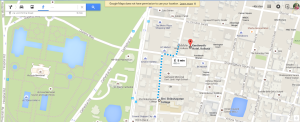 The map route looks rather vanilla.
The map route looks rather vanilla.
Here is what it really looks like:
This morning there was little traffic. Usually crossing the street is a life threatening experience as cars/rickshaws/motorcycles/trucks don’t ever stop unless the traffic light gets backed up. There are people heading to work, others begging on the streets, girls in their school uniforms walking to school, street vendors getting their day started among the blaring cacophony of honking horns, construction in nearby buildings, and people talking on their mobile phones. Entering the school gates brings some relative peace and the business of the streets is closed out.
Professional Development with Shri Shikshayatan Social Studies Teachers
Our host teacher Tansuree Ghosh asked my Social Studies partner Kim and I to each conduct a Social Studies professional development workshop for social studies teachers here at Shri Shikshayatan School. Kim modeled the Paideia Seminar with the workshop participants. I chose to focus on Social Studies Inquiry with Primary Source documents and used the set of documents I had put together about colonial reactions to the Stamp Act. This was a tried and true lesson that I taught to my 9th grade American Studies students and did as a quick professional development model for my colleagues at a faculty meeting last year.
Leading 20 Indian teachers through this lesson was really fun and engaging. Like my students, they were concerned that their responses to the prompts were correct and wanted to share their thinking with me. The follow up discussion focused on how to modify this activity in a variety of ways and how to assess student performance.
At the end of the workshop, teachers were talking amongst themselves and I heard some of the same comments I hear from US teachers, and have even said myself, at the end of PD sessions, “I don’t have time to do this, I already have so much to teach.” “My class size is too large” “My classroom doesn’t have enough space for this” “It takes too much time” and so forth. There are teaching challenges everywhere, there is never enough time, but we need to make the effort to try new things to benefit student learning.
Girls Speaking out at Shri Shikshayatan School
Four students at Shri Shikshayatan School gave speeches on Women’s Empowerment at a formal panel discussion this afternoon. The speeches were incredible. See for yourself!
Indian School Visits, Bangalore, India June 9 & 10, 2015
Here in Bangalore, our in-country education consultants are Maya Menon and Indira Subramanian. Maya is the Founding Director and Indira is the Head of Content Development for the Teacher Foundation. The Teacher Foundation’s vision is “To make schools enabling environments for all students by empowering educators to become energetic, effective, reflective practitioners and life-long learners.” (The Teacher Foundation)The Foundation works with teachers and schools to expand professional development opportunities so that teachers are “enabled and inspired” in changing their instructional practice from the traditional to the exceptional.
Before we headed out to visit schools, Maya gave an excellent overview of the Indian Education system so we could better understand why schools are the way they are.
Important points from Maya’s presentation to consider:
- India is complex, multiple realities exist.
- India is grappling with many challenges.
- India is a land of tremendous potential and opportunity.
- 2 billion people with the world’s youngest population with 450 million children under the age of 18 who want to learn.
- 22 Modern Indian languages coexist; 1576 mother tongues.
- Schools teach in 70 languages
- India does not have a stand alone Department of Education. It is part of the Ministry of Human Resources.
- Each Indian state also has ministries that oversee education.
- Parents can choose between government schools and private schools.
- Right to Education Act that states education is a fundamental right and that all children between the ages of 6 and 14 must be in school.
- Teacher shortage. Many teachers are untrained or poorly trained and it is a “noble” profession with little status and is female dominated.
- Administrators and Teacher Educators don’t know what is happening in the classrooms.
- Large class sizes that go beyond the 1 to 30 teacher/student ratio as stated by law.
- Teaching & learning English is the highest priority.
In both schools we observed, like in the US, that teachers do the best they can with the system they are in. Indian teachers must teach from the required textbooks and that doesn’t leave much room or support for creativity. Much of the teaching and learning was rote in nature and the students respectfully complied and were eager to show us their books and materials. One English teacher at the Vasanthnagar School used additional flash cards that she created herself, modeled the definitions of action verbs connected to the text, and engaged in a short discussion with the students. Her lesson was enthusiastic and fun which engaged the students. The English class that I observed at the Shastry School was taught straight out of the text with the teacher as the expert with students following along. Students were very compliant and excited that we were in class but this lesson was more indicative of the standard teaching and learning in Indian classrooms. The Vasanthnagar classrooms were small and dark with fixed benches, few materials but had beautifully painted alphabets in multiple languages, multiplication tables, and so forth on the walls. At Shastry, all of the classroom walls were bare and the interactive space was the chalkboard and teacher platform at the front of the room. I look forward to my week of observations at the Shri Shikshayatan School in Kolkata to learn more about day to day teaching and learning.
Driving in Bangalore?
Do.Not.Attempt.Ever.
Have you ever wondered about driving in India? As someone who is happy to drive just about anywhere, I would not be able to handle this. It is complete chaos, no rules, survival of the fittest driving on really horrendous roads.
Another way to look at it: Boston drivers and Boston road conditions look like disciplined German drivers on Germany’s very pristine and efficient road/highway system.
The pics really don’t do it justice. Yes, there are 3 people on that scooter and the women on the back is riding side-saddle as the driver weaves through traffic during morning rush hour. I’ve seen 4 people on a scooter with the mom tightly hanging on to her infant child! Fortunately, we are being driven around in a nice bus with a crazy driver.
What’s on Indian TV?
June 8, 2015 Bangalore, India Lemon Tree Hotel
After 20+ hours of travel 15 fellow teachers and I finally arrived at the Lemon Tree Hotel at 4am. After some much needed sleep, we regrouped for our opening presentation, had dinner, and then I headed back to my room at 9pm for bed.
There is a nice Samsung flatscreen tv in my room so I was really curious to find out what is on Indian television here in Bangalore and wondered how globalized Indian media is. By Indian standards, Bangalore is a smaller city. By small, I mean slightly larger than New York City with a population approaching 10 million people. Kolkata, Mumbai, and New Delhi are much larger.
Beginning at 9:30pm IST I started flipping through the channels.
News is big here. The English news channels included:
CNN
Times of India
Channel News Asia
New Delhi TV News
CNBC
Aljazzera
And at least 7 other non English news channels.
(There are also 3592 different newspapers published in 35 different languages)
Being a big CNN viewer at home, I was curious to see what CNN’s lead stories were:
Migrants in the Mediterranean
ISIS in Iraq
G7 Summit in Germany
Turkish Elections
FIFA Corruption Scandal
The big prison escape in Clinton, NY
Excessive Use of Police Force to Breakup a Teen Pool Party somewhere in Texas.
The presentation of the new stories was more “news” than entertainment with longer and more in-depth reporting that what we generally see in the U.S. It was rather refreshing not to see continued coverage of Caitlyn Jenner or the Duggar scandal.
On I went with my channel surfing…
While movie channels with Bollywood films are big, there are Hollywood films being broadcasted in equal number including:
The Matrix Reloaded
Terminator 2: Judgment Day
GI Joe and GI Joe Retaliation
Hercules
“Regular” TV channels included many Indian sit-coms and dramas but Grey’s Anatomy, The Mentalist, Law & Order, Scooby Doo cartoons, Doctor Who, India’s version of The Voice, and Britain’s Got Talent, were also available.
There wasn’t much in the sports department just Cricket and US Professional Wrestling. CNN sports update lead story was on LeBron James and the Cavs in the NBA finals, followed by the FIFA Women’s World Cup soccer.
There is TLC in India. So far, I have not seen evidence of Honey Boo Boo, 19 Kids and Counting, Say Yes to the Dress, or My 600lb Life I wonder if the Indian audience has similar “reality” shows focusing on certain demographic groups that equally fascinate and disgust the viewing audience.
Discovery Channel, FX, MTV India, Comedy Network (where is the Daily Show??), Nickleodean, Fox Life, National Geographic, History Channel, and Animal Planet were all had multiple channels of programming.
What does this all mean?
Major media conglomerates have significant exposure in the world’s second most populous country even when many people out in more rural areas have no access to tv, newspapers, or electricity. Only half of Indians own televisions but it is the 3rd largest television market in the world with over 700 satellite tv channels (India Mirror). “The Indian Media & Entertainment Industry grew by US$12.9 billion in 2009 to US$14.4 billion in 2010, a growth of 11 per cent, according to a report by the Federation of Indian Chambers of Commerce and Industry (FICCI) and research firm KPMG.(Wikipedia). Continued growth is predicted as infrastructure expands and programming continues to capture viewers in a very competitive market. The question remains is what impact will “western” vs. “eastern” programming have on the further globalization of India?
